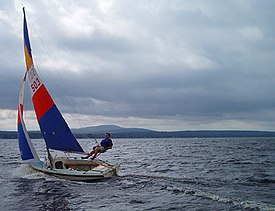CL 16
The CL 16 is a Canadian-designed 16' sloop sailboat, designed by Henry Croce and Ken Lofthouse in 1967-68 in Mahone Bay, NS. It is essentially the same design as the Wayfarer dinghy, with the addition of a double-hull and a more comfortable cockpit for recreational users. It was produced in Mahone Bay until 1968 when production was moved to the Toronto area. It continued to be produced by a Canadian company (C&L Boatworks) in Fort Erie, on Lake Erie, which began production in 1993 after being produced by David Waterhouse, Anne Waterhouse and Bob May in Pickering ON from 1969 to 1989. Now in 2018, CL BoatWorks was purchased by Velocity BoatWorks and all CL production has been moved to Belleville, Ontario on the Bay of Quinte.[5].
 | |
| Development | |
|---|---|
| Design | One-Design |
| Boat | |
| Crew | 2 |
| Draft | 0.20 m (7.9 in) 1.17 m (3 ft 10 in)[1] |
| Hull | |
| Type | Monohull |
| Construction | GRP with wood trim |
| Hull weight | 166 kg (366 lb)[1] |
| LOA | 4.88 m (16.0 ft)[1] |
| LWL | 4.52 m (14.8 ft)[1] |
| Beam | 1.85 m (6 ft 1 in)[1] |
| Rig | |
| Rig type | marconi rig |
| Mast length | 22' 7" |
| Sails | |
| Mainsail area | 9.236 m2 (99.42 sq ft)[1][2] |
| Jib/genoa area | 2.765 m2 (29.76 sq ft)[1][2] |
| Spinnaker area | 13.5 m2 (145 sq ft)[1][2] |
| Racing | |
| D-PN | 95.4[3][4] |
The CL 16 is an open cockpit boat that is extremely seaworthy and unsinkable due to a double hull design. CL16's and their Wayfarer cousins have circumnavigated the Great Lakes, and have crossed the North Sea.[6] They can be easily modified to run a spinnaker and/or trapeze. The CL 14 represents a smaller version of this stable craft, and that design shares dimensions somewhat resembling the Wanderer but lacks an after locker.
The design is said to be based upon the Ian Proctor's Wayfarer with tweaks by Graham Dodd and George Blanchard.[7] Unlike the Wayfarer, the class permits use of a trapeze.[1] The boat uses a retractable Centerboard. The sail plan consists of a marconi rig with a main, jib, and symmetrical spinnaker.
On the other hand, the iteration that was produced by C&L Boatworks first appeared in 1968; its strict one design has remained unchanged since then.[5]
The mast has a pin through it that acts as a pivot point, which is held in a tabernacle. When rigged with a tackle on the forestay, it can be lowered to pass beneath bridges. The pivot also facilitates mast raising.
As of 2013, it has a Portsmouth Yardstick rating of 95.4.[3] The C&L website says the rating is 97.[1]
The CL boatbuilder website differs from a sailmaker's statements about the rig's size. It claims that the boat carries sails that are: Main 95 sq.ft. 8.83 sq.m; Genoa 46 sq.ft. 4.27 sq.m.[1]
The owners' club may still be in existence.[8]
Notes
- "CL 16". C&L Boatworks. Retrieved 8 August 2013.
- "CL 16 Sail Plan CL 16 Sailboat Sail Plan Data and Sail Quoting System". Retrieved 8 August 2013.
- "Portsmouth Yardstick — current tables". US Sailing. Archived from the original on August 16, 2012. Retrieved August 7, 2013.
- "Centerboard Classes". US Sailing. Archived from the original on 16 August 2012. Retrieved 8 August 2013.
- "CL 14/16 -- built to last for the long haul". Outer Harbour Centreboard Club. Archived from the original on July 30, 2013. Retrieved July 20, 2013.
- Dye, Frank; Dye, Margaret (1977). Ocean-crossing wayfarer: to Iceland and Norway in an open boat [in a 16ft Open Dinghy]. Newton Abbott North Pomfret, Vt: David & Charles. ISBN 0-7153-7371-4.
- "CL 16". Sailboatdata.com. Retrieved July 20, 2013.
- "C & L Boatworks - Everything That's Old Is New Again!". Retrieved April 30, 2020.